The Coordinated Development and Identification of Obstacles in the Manufacturing Industry Based on Economy–Society–Resource–Environment Goals
Abstract
:1. Introduction
2. Literature Review
3. Data and Methodology
3.1. Data Source and Preprocessing
3.2. Evaluation Indicator System Construction
3.3. Research Methodology
3.3.1. CRITIC–Entropy Weight Method
3.3.2. Weighted TOPSIS Model
3.3.3. The Coupling Coordination Degree Model
3.3.4. Logarithmic Mean Divisia Index Method
3.3.5. Obstacle Degree Model
4. Results
4.1. Development Characteristics of Subsystems
4.1.1. Temporal Trend of Subsystems
4.1.2. Spatial Pattern of Subsystems
4.2. Coupling Coordinated Analysis
4.2.1. Temporal Analysis of CCD
4.2.2. Spatial Change of CCD
4.3. Coupling Coordination Degree Influencing Factor Analysis
4.3.1. The LMDI Decomposition Results
4.3.2. Obstacle Factor Analysis of Subsystem Development
4.4. Coordinated Trends in Different Scenarios
5. Discussion
6. Conclusions and Policy Implications
- (1)
- On the whole, the evaluation value of the economy and employment system is consistently increasing and presents the spatial characteristics of highest in the east and lowest in the west. The evaluation values of energy and carbon emissions have decreased, indicating a trend of high levels in the central areas and low levels in the east and west.
- (2)
- The overall coordination development level of the manufacturing industry in 30 provinces (cities) is at a primary coordinated level. Provinces exhibit variations in CCD due to disparities in economic development and resource allocation across different regions. While the majority of provinces have already achieved primary coordination, Qinghai and Xinjiang still require improvements in their CCD.
- (3)
- The LMDI decomposition results show that compared with the comprehensive coordination index, the coupling degree of the subsystem is the key to improving the level of coupling coordination. The evaluation values of economy, employment, and water have a positive impact on the coupling coordination level of most provinces.
- (4)
- Compared with the economy and employment, the CCD led by energy, water, and carbon is higher. This indicates that while advocating the sustainable development of the manufacturing industry, it is imperative to increase economic and social benefits, but it should not be at the expense of energy and water security or carbon emissions.
- (1)
- Strengthen the capacity for income distribution policy reform and enhance the employment attraction of the manufacturing industry. Economic and employment evaluations have a positive impact on the CCD. This is due to the rapid expansion of China’s manufacturing sector, which in turn increases the demand for workers. Therefore, it is necessary to improve the employment environment of workers in manufacturing enterprises, raise the wages of front-line workers, and boost the attractiveness of the manufacturing industry among the younger generation. It is essential to elevate residents’ labor income levels. Concurrently, regulate the income distribution process, establish a mechanism for tracking personal income and assets, and strengthen the safeguarding of citizens’ lawful property rights and interests.
- (2)
- Enhancing and enforcing legislation and benchmarks related to energy efficiency and carbon emissions is essential to preserve the ecological environment through robust institutional frameworks. The CCD is negatively impacted by the evaluation values of energy and carbon systems, indicating that the growth of manufacturing at the expense of significant energy inputs and carbon emissions has resulted in a decrease in economic sustainability. Develop and enforce public policies aimed at fostering environmental conservation, and encourage governmental agencies, manufacturing firms, and individuals to engage proactively in environmental protection efforts through these policies. It is necessary to actively develop clean energy technologies, to strengthen research and development in energy conservation and emission reduction technologies, and to utilize advanced emission reduction technologies to improve energy efficiency. We aim to enhance the development of environmental infrastructure, offer environmental public services, boost the availability of superior ecological products, and fulfill the public’s needs for high-quality ecological offerings.
- (3)
- Promote the growth of regionally advantageous industrial clusters and explore differentiated regional development strategies. The research results indicate that the evaluation values of subsystems in different regions have varying effects on the CCD. Consequently, different provinces or cities should implement different measures to improve the development level of their respective subsystems. Therefore, emphasizing advantageous industries is crucial for the sustainable development of the regional manufacturing industry. The eastern coastal areas should actively play a radiation-driven and diffusion-driven role. The central provinces (cities) should continue to open up domestically and internationally, gradually establishing a comprehensive, multi-layered, and extensive opening pattern. They should develop inland open economic zones and expedite the realization of the Central Plains’ rise. The western regions should accelerate the formation of a modern industrial layout and develop new business formats and tools like cloud computing, big data, and artificial intelligence. The northeastern regions should accelerate the process of upgrading and transforming the declining industries within the old industrial bases and increase investment in innovation to realize the transition from old to new driving forces in the manufacturing industry.
- (4)
- Strengthen regional cooperation to promote the spatial balance of sustainable development in the manufacturing industry. Significant disparities exist in the evaluation values of the subsystems and CCD across the four regions. There are significant disparities in the evaluation values of the subsystems and CCD of the four regions. It is essential to eliminate institutional barriers that impede the flow of production factors, get rid of barriers to regional markets, facilitate the mobility of innovation-driven elements and resources within the manufacturing sector, and enhance the efficiency of production factor allocation across various regions. Develop a regional transmission mechanism that facilitates the sustainable development of the manufacturing sector across the eastern coastal regions and their central and western counterparts, delve into collaborative and developmental frameworks between different regions, and foster the collective advancement of both prosperous and less developed areas.
Author Contributions
Funding
Data Availability Statement
Conflicts of Interest
Appendix A
| Energy Type | Conversion Factor (tec/t) | Carbon Emission Coefficient | Energy Type | Conversion Factor (tec/t) | Carbon Emission Coefficient |
|---|---|---|---|---|---|
| Raw Coal | 0.7143 | 1.900 (CO2/t) | Diesel Oil | 1.4571 | 3.096 (CO2/t) |
| Coke | 0.9714 | 2.860 (CO2/t) | Fuel Oil | 1.4286 | 3.17 (CO2/t) |
| Crude Oil | 1.4286 | 3.020 (CO2/t) | Natural Gas | 1.3300 | 1.790 (CO2/m3) |
| Gasoline | 1.4714 | 2.925 (CO2/t) | Electricity | 0.123 | 2.213 (kw·h) |
| Kerosene | 1.4714 | 3.018 (CO2/t) |
| Region | Coupling Degree | Coupling Coordination Degree | |||||
|---|---|---|---|---|---|---|---|
| Base Scenario | Economy-Led Scenario | Employment-Led Scenario | Energy-Led Scenario | Water-Led Scenario | Carbon-Led Scenario | ||
| Beijing | 0.8101 | 0.7363 | 0.6328 | 0.6465 | 0.7891 | 0.8008 | 0.7926 |
| Tianjin | 0.8201 | 0.7014 | 0.6161 | 0.6074 | 0.7399 | 0.7823 | 0.7426 |
| Hebei | 0.8310 | 0.6892 | 0.6181 | 0.5930 | 0.7350 | 0.7702 | 0.7126 |
| Shanxi | 0.7682 | 0.6640 | 0.5795 | 0.5615 | 0.7239 | 0.7442 | 0.6897 |
| Inner Mongolia | 0.7859 | 0.6107 | 0.5462 | 0.5255 | 0.6681 | 0.7184 | 0.5726 |
| Liaoning | 0.8107 | 0.6807 | 0.5970 | 0.5869 | 0.7261 | 0.7611 | 0.7138 |
| Jilin | 0.7266 | 0.6717 | 0.5660 | 0.5713 | 0.7310 | 0.7383 | 0.7277 |
| Heilongjiang | 0.6773 | 0.6326 | 0.5255 | 0.5332 | 0.6939 | 0.6962 | 0.6886 |
| Shanghai | 0.9066 | 0.7654 | 0.7005 | 0.6849 | 0.8146 | 0.8051 | 0.8111 |
| Jiangsu | 0.9828 | 0.7612 | 0.8122 | 0.7525 | 0.7622 | 0.7334 | 0.7431 |
| Zhejiang | 0.9640 | 0.7876 | 0.7734 | 0.7285 | 0.8094 | 0.8450 | 0.7769 |
| Anhui | 0.8537 | 0.7092 | 0.6391 | 0.6156 | 0.7725 | 0.7487 | 0.7549 |
| Fujian | 0.8996 | 0.7600 | 0.7174 | 0.6651 | 0.8057 | 0.8123 | 0.7885 |
| Jiangxi | 0.8186 | 0.7112 | 0.6340 | 0.6082 | 0.7760 | 0.7597 | 0.7601 |
| Shandong | 0.9434 | 0.7217 | 0.7075 | 0.6634 | 0.7246 | 0.8054 | 0.6999 |
| Henan | 0.8853 | 0.7456 | 0.6855 | 0.6539 | 0.7915 | 0.8044 | 0.7803 |
| Hubei | 0.8594 | 0.7259 | 0.6647 | 0.6270 | 0.7887 | 0.7625 | 0.7723 |
| Hunan | 0.8326 | 0.7223 | 0.6496 | 0.6195 | 0.7847 | 0.7659 | 0.7747 |
| Guangdong | 0.9918 | 0.8632 | 0.8811 | 0.8782 | 0.8593 | 0.8704 | 0.8258 |
| Guangxi | 0.7268 | 0.6525 | 0.5531 | 0.5518 | 0.7248 | 0.7120 | 0.6970 |
| Hainan | 0.6174 | 0.5809 | 0.4731 | 0.4917 | 0.6075 | 0.6610 | 0.6449 |
| Chongqing | 0.7988 | 0.6810 | 0.5988 | 0.5823 | 0.7031 | 0.7581 | 0.7429 |
| Sichuan | 0.8717 | 0.6970 | 0.6442 | 0.6095 | 0.6897 | 0.7807 | 0.7465 |
| Guizhou | 0.7334 | 0.6683 | 0.5677 | 0.5660 | 0.7383 | 0.7328 | 0.7130 |
| Yunnan | 0.7366 | 0.6612 | 0.5629 | 0.5599 | 0.7286 | 0.7318 | 0.6992 |
| Shaanxi | 0.8103 | 0.6959 | 0.6198 | 0.5934 | 0.7375 | 0.7734 | 0.7369 |
| Gansu | 0.6733 | 0.6245 | 0.5178 | 0.5275 | 0.6944 | 0.6998 | 0.6574 |
| Qinghai | 0.7231 | 0.5850 | 0.4930 | 0.5010 | 0.6191 | 0.6913 | 0.5965 |
| Ningxia | 0.7393 | 0.6046 | 0.5176 | 0.5159 | 0.6660 | 0.7051 | 0.5941 |
| Xinjiang | 0.7645 | 0.5880 | 0.5064 | 0.5072 | 0.6140 | 0.7016 | 0.5881 |
References
- China. 2024. Available online: https://www.163.com/dy/article/J6B37IEL051492T3.html (accessed on 16 January 2025).
- Wang, H.; Li, B. Environmental regulations, capacity utilization, and high-quality development of manufacturing: An analysis based on Chinese provincial panel data. Sci. Rep. 2021, 11, 19566. [Google Scholar] [CrossRef]
- China. The 14th Five-Year Plan for National Economic and Social Development of the People’s Republic of China and the Outline of the Long-Range Goals for 2035. 2021. Available online: https://www.gov.cn/xinwen/2021-03/13/content_5592681.htm (accessed on 16 January 2025).
- Lin, C.; Qiao, W. Statistical Measurements and Club Effects of High-Quality Development in Chinese Manufacturing. Int. J. Environ. Res. Public Health 2022, 19, 16228. [Google Scholar] [CrossRef] [PubMed]
- Wang, H.; Cao, W.; Wang, F. Digital Transformation and Manufacturing Firm Performance: Evidence from China. Sustainability 2022, 14, 10212. [Google Scholar] [CrossRef]
- Chen, S.; Yu, L.; Zhang, C.; Wu, F.; Li, T. Environmental impact assessment of multi-source solid waste based on a life cycle assessment, principal component analysis, and random forest algorithm. J. Environ. Manag. 2023, 339, 117942. [Google Scholar] [CrossRef]
- Rehman, N.U.; Nunziante, G. The effect of the digital economy on total factor productivity in European regions. Telecommun. Policy 2023, 47, 102650. [Google Scholar] [CrossRef]
- Cook, D.; Davíðsdóttir, B. An appraisal of interlinkages between macro-economic indicators of economic well-being and the sustainable development goals. Ecol. Econ. 2021, 184, 106996. [Google Scholar] [CrossRef]
- Huang, Y.; Chen, Z.; Yin, S. Spatial spillover effects of the digital economy on the green total factor productivity of China’s manufacturing industry. Environ. Impact Assess. Rev. 2024, 6, 065006. [Google Scholar] [CrossRef]
- Kuosmanen, N.; Maczulskij, T. Going green while getting lean: Decomposing carbon and green total factor productivity. J. Environ. Manag. 2024, 352, 120046. [Google Scholar] [CrossRef]
- Sun, K.; Han, J.; Wu, Q.; Xie, W.; He, W.; Yang, Z.; Wang, Y.; Liu, J.; Shi, E. The coupling coordination and spatiotemporal evolution of industrial water-energy-CO2 in the Yellow River Basin. Sci. Total Environ. 2024, 912, 169012. [Google Scholar] [CrossRef] [PubMed]
- Gonella, J.D.L.; Godinho, M.; Ganga, G.M.D.; Lizarelli, F.L. From awareness to action: Understanding the relationship between circular economy and favourable evaluation towards sustainable development. Bus. Strategy Environ. 2024, 33, 8679–8694. [Google Scholar] [CrossRef]
- Mackay, B.R.; Shaker, R.R. A Megacities Review: Comparing Indicator-Based Evaluations ofSustainable Development and Urban Resilience. Sustainability 2024, 16, 8067. [Google Scholar] [CrossRef]
- Zhang, J.; Hou, Y.; Liu, P.; He, J.; Zhuo, X. The goal requirements and strategic path of high-quality development. J. Manag. World 2019, 35, 1–7. [Google Scholar]
- Mansour, F.; Al-Hindi, M.; Yasine, A.; Najjar, E. Multi-criteria approach for the selection of water, energy, food nexus assessment tools and a case study application. J. Environ. Manag. 2022, 322, 116139. [Google Scholar] [CrossRef] [PubMed]
- Mhana, K.; Awad, H. An ideal location selection of electric vehicle charging stations: Employment of integrated analytical hierarchy process with geographical information system. Sustain. Cities Soc. 2024, 107, 105456. [Google Scholar] [CrossRef]
- Yang, Z.; Tuo, Y.; Yang, J.; Wu, Y.; Gong, Z.; Feng, G. Integrated prediction of summer precipitation in China based on multi dynamic-statistic methods. Chin. J. Geophys.-Chin. Ed. 2024, 67, 982–996. [Google Scholar]
- Sun, Y.; Zhao, T.; Xia, L. Spatial-temporal differentiation of carbon efficiency and coupling coordination degree of Chinese county territory and obstacles analysis. Sustain. Cities Soc. 2022, 76, 103429. [Google Scholar] [CrossRef]
- Song, Q.; Wang, Z.; Wu, T. Risk analysis and assessment of water resource carrying capacity based on weighted gray model with improved entropy weighting method in the central plains region of China. Ecol. Indic. 2024, 160, 111907. [Google Scholar] [CrossRef]
- Cheba, K.; Bak, I.; Szopik-Depczynska, K.; loppolo, G. Directions of green transformation of the European Union countries. Ecol. Indic. 2022, 136, 108601. [Google Scholar] [CrossRef]
- Mathew, M.; Chakrabortty, R.; Ryan, M. Selection of an Optimal Maintenance Strategy Under Uncertain Conditions: An Interval Type-2 Fuzzy AHP-TOPSIS Method. IEEE Trans. Eng. Manag. 2022, 69, 1121–1134. [Google Scholar] [CrossRef]
- Boori, M.; Choudhary, K.; Paringer, R.; Kupriyanov, A. Spatiotemporal ecological vulnerability analysis with statistical correlation based on satellite remote sensing in Samara, Russia. J. Environ. Manag. 2021, 285, 112138. [Google Scholar] [CrossRef]
- Zhang, Y.; Zhu, T.; Guo, H.; Yang, X. Analysis of the coupling coordination degree of the Society-Economy-Resource-Environment system in urban areas: Case study of the Jingjinji urban agglomeration, China. Ecol. Indic. 2023, 146, 109851. [Google Scholar] [CrossRef]
- Wu, X.; Hao, C.; Li, Y.; Ge, C.; Duan, X.; Ren, J.; Han, C. Spatio-temporal coupling coordination analysis between localgovernments’ environmental performance and listed companies’ ESG performance. Environ. Impact Assess. Rev. 2025, 110, 107655. [Google Scholar] [CrossRef]
- Caglar, M.; Nisel, S. Efficiency measurement of fintech companies: A two-stage DEA approach. Electron. Commer. Res. 2024, 24, 1335–1366. [Google Scholar] [CrossRef]
- Wang, L.; Shao, J. Can Digitalization Improve the High-quality Development of Manufacturing? An Analysis Based on Chinese Provincial Panel Data. J. Knowl. Econ. 2023, 15, 2010–2036. [Google Scholar] [CrossRef]
- Wang, S.; Xue, Z. How Does the Digital Economy Empower the High-Quality Development of Manufacturing Industry?—Based on the Test of Mediation Effect and Threshold Effect. J. Knowl. Econ. 2024. [Google Scholar] [CrossRef]
- Dou, Z.; Wu, B.; Sun, Y.; Wang, T. The Competitiveness of Manufacturing and Its Driving Factors: A Case Study of G20 Participating Countries. Sustainability 2021, 13, 1143. [Google Scholar] [CrossRef]
- Shen, Q.; Zhu, J.; Qi, M.; Tao, X. Can environmental, social, and governance performance improve the high-quality development of equipment manufacturing companies? Transform. Bus. Econ. 2023, 22, 625–652. [Google Scholar]
- Zhong, J.; Tang, Y. Empirical Analysis of R&D Investment, Industrial Structure Transformation and Development of High-tech Industry in Guangdong Province—Based on Time Series Data from 2003–2018. IOP Conf. Ser. Earth Environ. Sci. 2019, 358, 032048. [Google Scholar]
- Hu, J.; Xue, H.; Yu, Z. Study on the Effect of R&D Investment on Technical progress of Manufacture in China. J. Knowl. Econ. 2023, 15, 9899. [Google Scholar]
- Wang, L.; Wang, Z.; Ma, Y. Does environmental regulation promote the high-quality development of manufacturing? A quasi-natural experiment based on China’s carbon emission trading pilot scheme. Socio-Econ. Plan. Sci. 2022, 81, 101216. [Google Scholar] [CrossRef]
- Han, D. The Growth of Service Sectors, Institutional Environment and Quality Development in China’s Manufacturing. Systems 2023, 11, 128. [Google Scholar] [CrossRef]
- Liu, Y.; He, Z. Synergistic industrial agglomeration, new quality productive forces andhigh-quality development of the manufacturing industry. Int. Rev. Econ. Financ. 2024, 94, 103373. [Google Scholar] [CrossRef]
- Wang, M.; Zhang, M.; Chen, H.; Yu, D. How Does Digital Economy Promote the Geographical Agglomeration of Manufacturing Industry? Sustainability 2023, 15, 1727. [Google Scholar] [CrossRef]
- Guo, Q.; Su, Z. The Application of Industrial Robot and the High-Quality Development of Manufacturing Industry: From a Sustainability Perspective. Sustainability 2023, 15, 12621. [Google Scholar] [CrossRef]
- Zhang, Z.; Shi, K.; Tang, L.; Su, K.; Zhu, Z.; Yang, Q. Exploring the spatiotemporal evolution and coordination of agricultural green efficiency and food security in China using ESTDA and CCD models. J. Clean. Prod. 2022, 374, 133976. [Google Scholar] [CrossRef]
- Guan, X.; Wei, H.; Lu, S.; Su, H. Mismatch distribution of population and industry in China: Pattern, problems and driving factors. Appl. Geogr. 2018, 97, 61–74. [Google Scholar] [CrossRef]
- Duan, H.; Sun, X.; Song, J.; Xing, J.; Yang, W. Peaking carbon emissions under a coupled socioeconomic-energy system: Evidence from typical developed countries. Resour. Constr. Recycl. 2022, 187, 106641. [Google Scholar] [CrossRef]
- Zhang, X. Theory of Sustainable Development:Concept Evolution, Dimension and Prospect. Bull. Chin. Acad. Sci. 2018, 33, 10–19. [Google Scholar]
- Sun, X.; Shao, H.; Liang, S.; Zhou, Y.; Dai, X.; Liu, M.; Tao, R.; Guo, Z.; Xin, Q. Tracking sustainable development in mining towns: A novel framework integrating socioeconomic and eco-environmental perspectives through coupling coordination degree. Environ. Impact Assess. Rev. 2024, 109, 107641. [Google Scholar] [CrossRef]
- Lin, Y.; Chen, P.; Zhang, M. Conflict or synergy? Analysis of economic-social- infrastructure-ecological resilience and their coupling coordination in the Yangtze River economic Belt, China. Ecol. Indic. 2022, 142, 109194. [Google Scholar] [CrossRef]
- Su, Y. Research on the Evaluation of High-quality Development of Manufacturing Industry in the Central Region of China: Analysis based on the Data from 2007 to 2018. Econ. Probl. 2020, 9, 85–91. [Google Scholar]
- Han, Z.; Liu, Y.; Guo, X.; Xu, J. Regional differences of high-quality development level for manufacturing industry in China. Math. Biosci. Eng. 2022, 19, 4368–4395. [Google Scholar] [CrossRef]
- Su, Y.; Shi, J.; Zhang, M. Research on the Construction and Measurement of the HQDMI Evaluation Index System—A Case Study of China. Sustainability 2022, 14, 15364. [Google Scholar] [CrossRef]
- Zhang, C.; Zhao, L.; Song, X.; Zhang, Q.; Zhang, X. Spatial-temporal coupling characteristics and interaction effects of 78 cities in the Yellow River Basineconomic resilience and people’s livelihoods and well-being: An analysis of 78 cities in the Yellow River Basin. Sustain. Cities Soc. 2024, 112, 105638. [Google Scholar] [CrossRef]
- Wang, Y.; Song, J.; Sun, H. Coupling interactions and spatial equilibrium analysis of water-energy-food in the Yellow River Basin, China. Sustain. Cities Soc. 2023, 88, 104293. [Google Scholar] [CrossRef]
- Zhang, X.; Jie, X.; Ning, S.; Wang, K.; Li, X. Coupling and coordinated development of urban land use economic efficiency and green manufacturing systems in the Chengdu-Chongqing Economic Circle. Sustain. Cities Soc. 2022, 85, 104012. [Google Scholar] [CrossRef]
- Feng, M.; Chen, Y.; Duan, W.; Zhu, Z.; Wang, C.; Hu, Y. Water-energy-carbon emissions nexus analysis of crop production in the Tarim river basin, Northwest China. J. Clean. Prod. 2023, 396, 136566. [Google Scholar] [CrossRef]
- Zhang, J.; Dong, Z. Assessment of coupling coordination degree and water resources carrying capacity of Hebei Province (China) based on WRESP2D2P framework and GTWR approach. Sustain. Cities Soc. 2022, 82, 103862. [Google Scholar] [CrossRef]
- Jiang, J.; Zhu, S.; Wang, W.; Li, Y.; Li, N. Coupling coordination between new urbanisation and carbon emissions in China. Sci. Total Environ. 2022, 850, 158076. [Google Scholar] [CrossRef]
- Shen, L.; Huang, Y.; Huang, Z.; Lou, Y.; Ye, G.; Wong, S. Improved coupling analysis on the coordination between socio-economy and carbon emission. Ecol. Indic. 2018, 94, 357–366. [Google Scholar] [CrossRef]
- Diakoulaki, D.; Mavrotas, G.; Papayannakis, L. Determining objective weights in multiple criteria problems: The CRITIC method. Comput. Oper. Res. 1995, 22, 763–770. [Google Scholar] [CrossRef]
- Tao, C.; Chen, W.; Lin, L. An Empirical Analysis on the Synergy Degree of Industrial Organization Evolution in China:Taking the IT Industry in China under the Background of Enterprise Integration as an Example. J. Manag. World 2007, 12, 67–72. [Google Scholar]
- Wu, Z.; Guan, J.; He, J. An Empirical Study on the Calculation of Minimum Wage Standard-Dynamic Combination Calculation Based on Objective Weight of CRITIC-Entropy Weight Method. Mod. Econ. Sci. 2019, 41, 103–117. [Google Scholar]
- Hooshangi, N.; Gharakhanlou, N.M.; Razin, S.R.G. Evaluation of potential sites in Iran to localize solar farms using a GIS-based Fermatean Fuzzy Topsis. J. Clean. Prod. 2023, 384, 135481. [Google Scholar] [CrossRef]
- Zhang, Q.; Tang, X.; Xiao, Y.; Xiang, X.; Huang, H. Coordination of industrial structure and eco-efficiency in ecologically fragile areas: A case study of the Loess Plateau, China. J. Environ. Manag. 2023, 331, 117237. [Google Scholar] [CrossRef] [PubMed]
- Tang, F.; Wang, L.; Guo, Y.; Fu, M.; Huang, N.; Duan, W.; Luo, M.; Zhang, J.; Li, W.; Song, W. Spatio-temporal variation and coupling coordination relationship between urbanisation and habitat quality in the Grand Canal, China. Land Use Policy 2022, 117, 106119. [Google Scholar] [CrossRef]
- Hou, M.; Cui, X.; Xie, Y.; Lu, W.; Xi, Z. Synergistic emission reduction effect of pollution and carbon in China’s agricultural sector: Regional differences, dominant factors, and their spatial-temporal heterogeneity. Environ. Impact Assess. Rev. 2024, 106, 107543. [Google Scholar] [CrossRef]
- Fan, X. Research on the coupling of ecological environment and socio-economic development in resource-based cities: Based on scenario simulation method. Sustain. Cities Soc. 2024, 114, 105810. [Google Scholar] [CrossRef]
- Ang, B. The LMDI approach to decomposition analysis: A practical guide. Energy Policy 2005, 33, 867–871. [Google Scholar] [CrossRef]
- Ang, B.; Liu, N. Negative-value problems of the logarithmic mean divisia index decomposition approach. Energy Policy 2007, 35, 739–742. [Google Scholar] [CrossRef]
- Raza, M.; Lin, B. The impact of the productive sectors on CO2 emissions in Pakistan. Environ. Impact Assess. Rev. 2025, 110, 107643. [Google Scholar] [CrossRef]
- Rivera-Niquepa, J.D.; Jesus, P.M.D.; Yusta, J.M. Trend-based multi-period decomposition and decoupling methodology for energy-related carbon dioxide emissions: A case study of Portugal. Util. Policy 2025, 93, 101863. [Google Scholar] [CrossRef]
- Zhang, J.; Yan, Z.; Bi, W.; Ni, P.; Lei, F.; Yao, S.; Lang, J. Prediction and scenario simulation of the carbon emissions of public buildings in the operation stage based on an energy audit in Xi’an, China. Energy Policy 2023, 173, 113396. [Google Scholar] [CrossRef]
- Xu, X.; Zhang, Z.; Long, T.; Sun, S.; Gao, J. Mega-city region sustainability assessment and obstacles identification with GIS-entropy—TOPSIS model: A case in Yangtze River Delta urban agglomeration, China. J. Clean. Prod. 2021, 294, 126147. [Google Scholar] [CrossRef]
- Bian, D.; Yang, X.; Xiang, W.; Sun, B.; Chen, Y.; Babuna, P.; Li, M.; Yuan, Z. A new model to evaluate water resource spatial equilibrium based on the game theory coupling weight method and the coupling coordination degree. J. Clean. Prod. 2022, 366, 132907. [Google Scholar] [CrossRef]
- Ji, Z.; Yu, W. Spatial differences and driving mechanism of industrial water use efficiency in China. J. Ind. Technol. Econ. 2022, 41, 86–93. [Google Scholar]
- Ye, B.; Jiang, J.; Li, C.; Miao, L.; Tang, J. Quantifification and driving force analysis of provincial-level carbon emissions in China. Appl. Energy 2017, 198, 223–238. [Google Scholar] [CrossRef]
- Ren, L.; Wang, W.; Wang, J.; Liu, R. Analysis of energy consumption and carbon emission during the urbanization of Shandong Province, China. J. Clean Prod. 2015, 103, 534–541. [Google Scholar] [CrossRef]
- Wang, Q.; Jiang, R. Is China’s economic growth decoupled from carbon emissions? J. Clean Prod. 2019, 225, 1195–1208. [Google Scholar] [CrossRef]
- Dubey, R.; Gunasekaran, A.; Ali, S. Exploring the relationship between leadership, operational practices, institutional pressures and environmental performance: A framework for green supply chain. Int. J. Prod. Econ. 2015, 160, 120–132. [Google Scholar] [CrossRef]
- Xue, R.; Zhang, J.; Liu, H.; Li, K.; Baron, C. How does outward foreign direct investment influence manufacturing industry sustainable growth in China? Appl. Econ. 2024, 56, 2752–2768. [Google Scholar] [CrossRef]
- Liu, H.; Wang, Y.; Ji, L. Characteristics, mechanism and pattern of inter-regional industrial transfers in China. Econ. Geogr. 2021, 34, 102–107. [Google Scholar]
- Li, F.; Xu, X.; Li, Z.; Du, P.; Ye, J. Can low-carbon technological innovation truly improve enterprise performance? The case of Chinese manufacturing companies. J. Clean Prod. 2021, 293, 125949. [Google Scholar] [CrossRef]
- Zhou, L.; Tian, L.; Gao, Y.; Ling, Y.; Fan, C.; Hou, D.; Shen, T. How did industrial land supply respond to transitions in state strategy? An analysis of prefecture-level cities in China from 2007 to 2016. Land Use Policy 2019, 87, 104009. [Google Scholar] [CrossRef]
- Xiang, L. Evaluation of the dynamics of manufacturing development and its high quality development level in western China. Stat. Decis. 2023, 39, 120–124. [Google Scholar]
- Zhang, L.; Zhu, N. Research on evaluation of high-quality development of manufacturing industry in central region of China based on entropy value method. J. Xiangtan Univ. (Philos. Soc. Sci.) 2022, 46, 46–51. [Google Scholar]
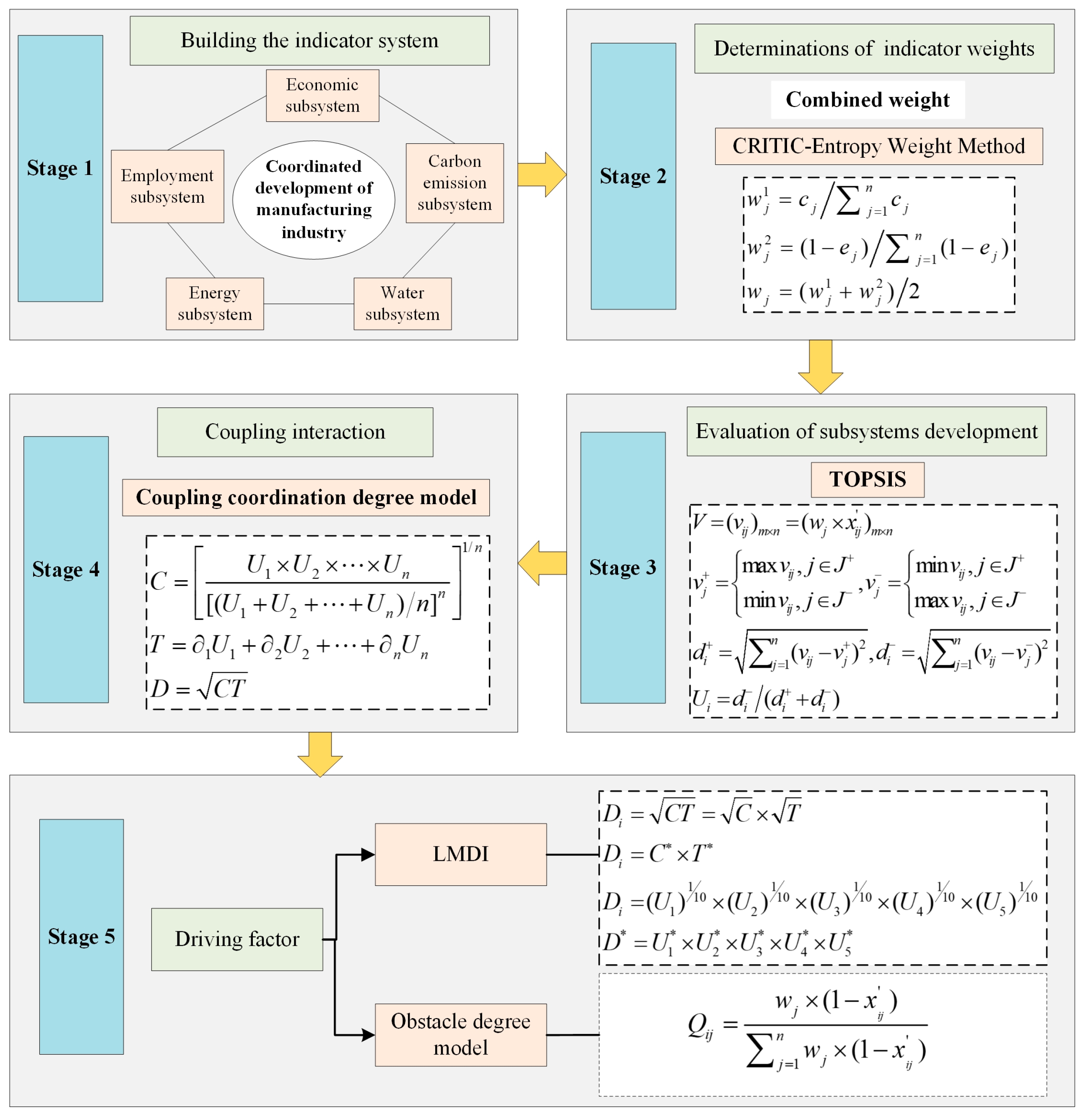

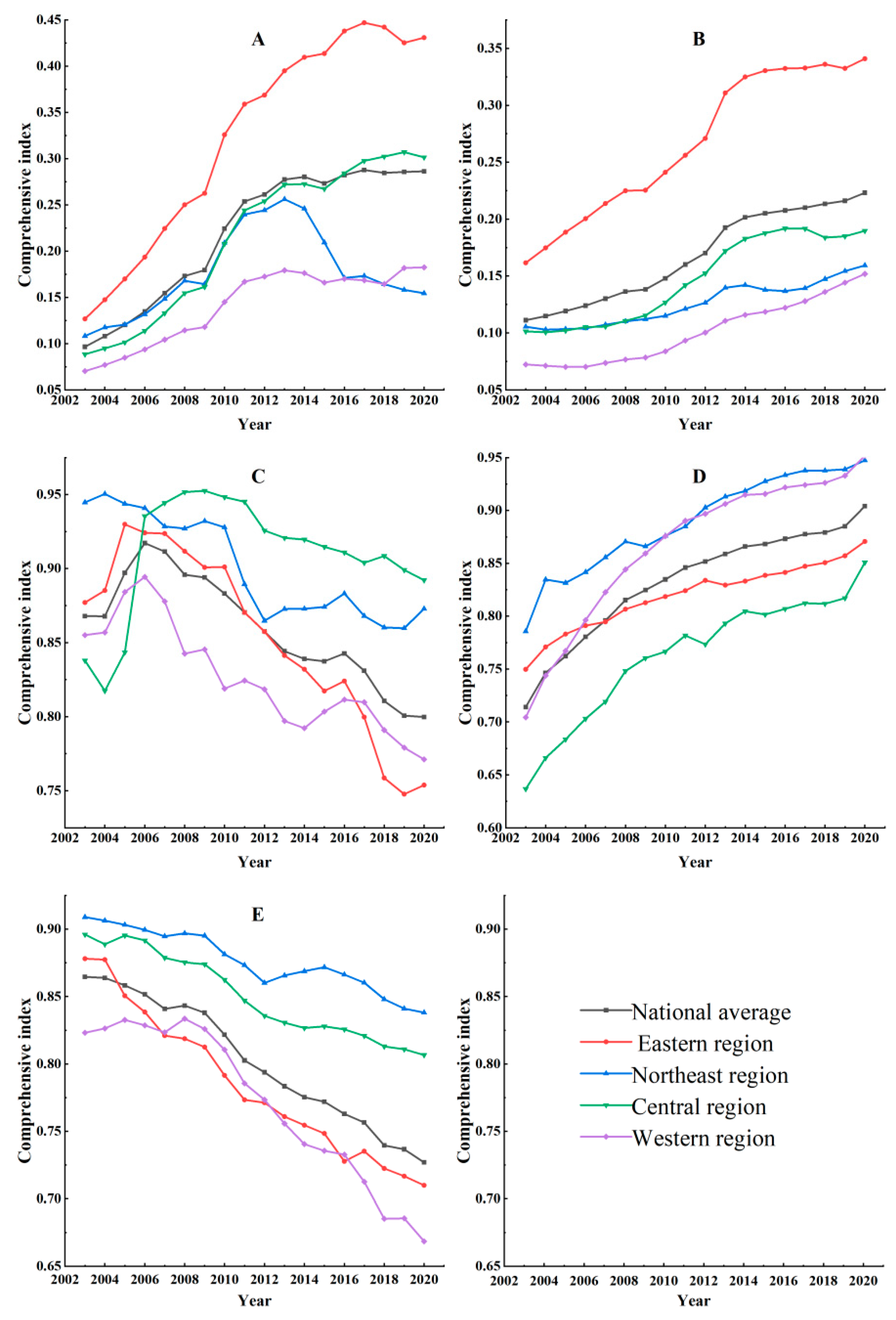

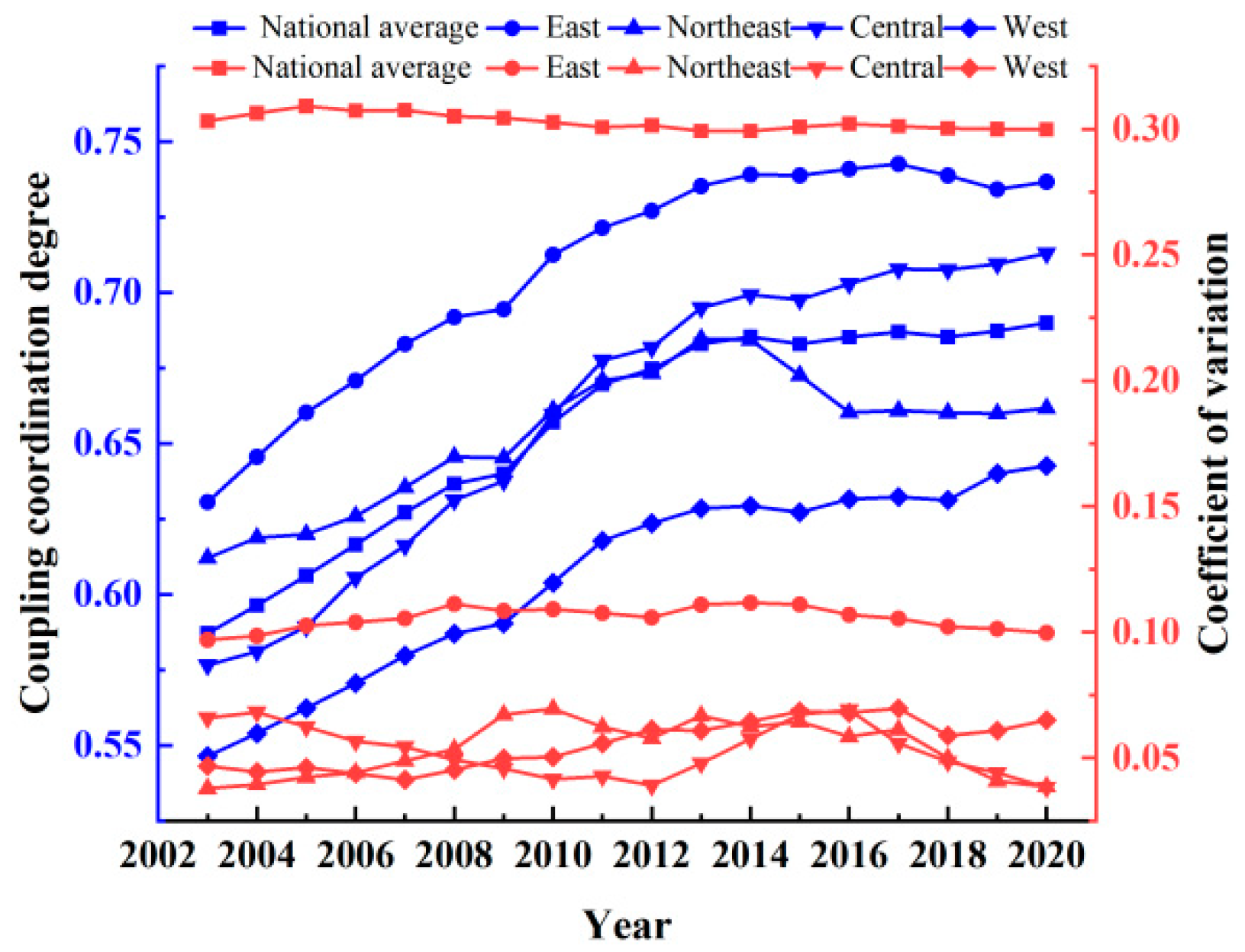

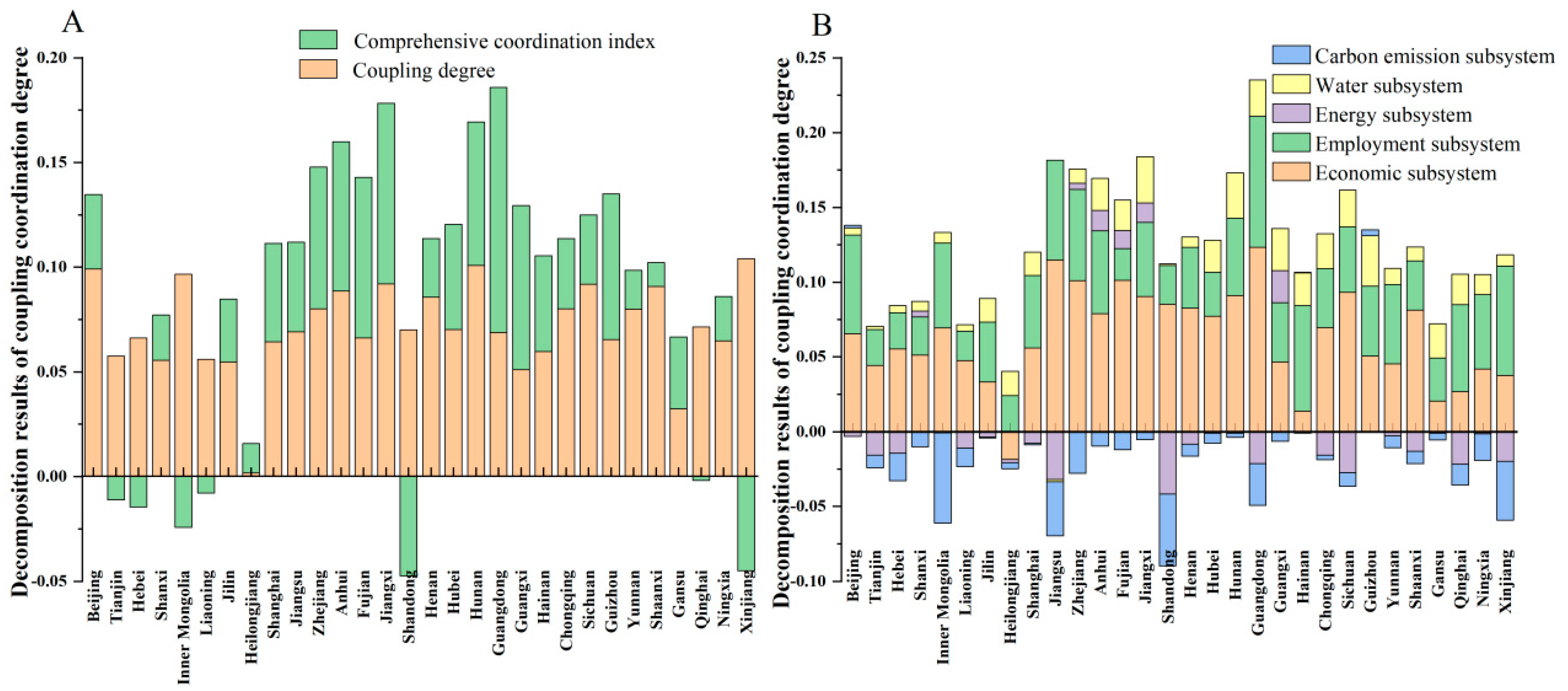
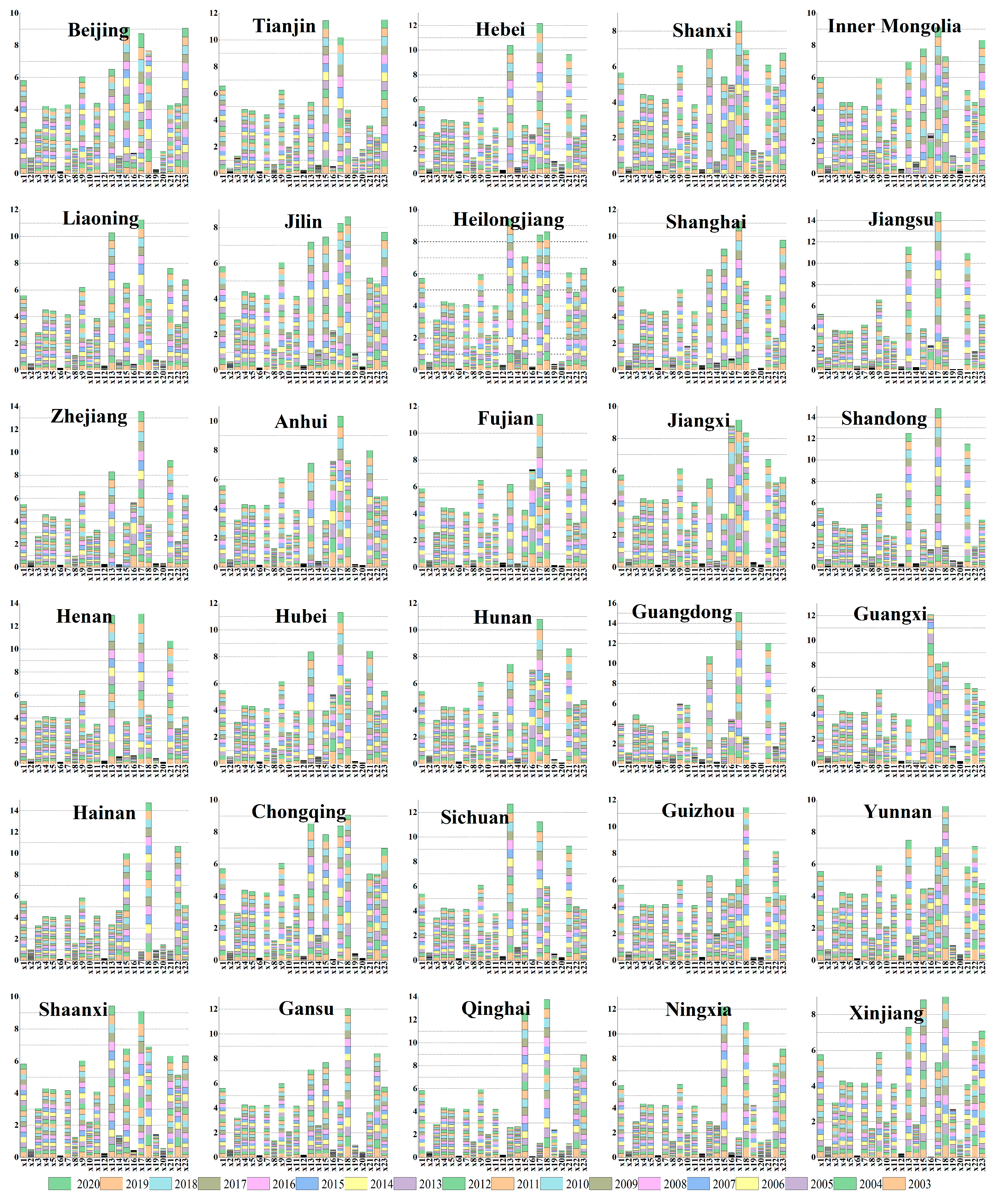
| Subsystem | Indicator | Variables | Combined Weight | Property | Reference |
|---|---|---|---|---|---|
| Economic subsystem | Industrial added value (RMB 10 million) | x1 | 0.2928 | Positive | [41] |
| Proportion of industrial added value | x2 | 0.0582 | Positive | [42] | |
| Per capita industrial added value | x3 | 0.1802 | Positive | [43] | |
| Primary revenue generated by industrial enterprises above designated size (RMB 10 million) | x4 | 0.2275 | Positive | ||
| Aggregate profits of industrial enterprises above designated size (RMB 100 million) | x5 | 0.2237 | Positive | ||
| Sales profit margin | x6 | 0.0177 | Positive | [44] | |
| Employment subsystem | Total number of employees in manufacturing sector | x7 | 0.2194 | Positive | |
| Percentage of workforce employed in the manufacturing sector | x8 | 0.0909 | Positive | [44] | |
| Total wage of workers in manufacturing sector (RMB 100 million) | x9 | 0.3078 | Positive | [45] | |
| Mean salary of workers in manufacturing sector (RMB) | x10 | 0.1354 | Positive | [44] | |
| Mean number of employees hired by industrial enterprises above designated size (10,000 persons) | x11 | 0.2183 | Positive | ||
| Urban registered unemployment rate (%) | x12 | 0.0282 | Negative | [46] | |
| Energy subsystem | Total industrial energy consumption (100 million tons) | x13 | 0.3027 | Negative | [47] |
| Energy intensity of industrial production | x14 | 0.1429 | Negative | [48] | |
| Per capita industrial energy consumption | x15 | 0.3153 | Negative | ||
| Ratio of coal usage to total energy consumption (%) | x16 | 0.2391 | Negative | [47] | |
| Water subsystem | Total industrial water consumption | x17 | 0.4369 | Negative | |
| Water consumption per unit of industrial added value | x18 | 0.3811 | Negative | [47,49] | |
| Industrial wastewater discharge of unit added value | x19 | 0.1222 | Negative | [48,50] | |
| Intensity of industrial wastewater treatment | x20 | 0.0597 | Negative | [47] | |
| Carbon emission system | Total industrial carbon emissions | x21 | 0.3623 | Negative | [51] |
| Industrial carbon emission of unit added value | x22 | 0.2784 | Negative | [52] | |
| Industrial carbon emissions per capita | x23 | 0.3592 | Negative | [49] |
| D | Coordination Types | D | Coordination Types |
|---|---|---|---|
| Extreme imbalance | Near coordination | ||
| Serious imbalance | Primary coordination | ||
| Moderate imbalance | Moderate coordination | ||
| Mild imbalance | Good coordination | ||
| Imminent imbalance | Excellent coordination |
Disclaimer/Publisher’s Note: The statements, opinions and data contained in all publications are solely those of the individual author(s) and contributor(s) and not of MDPI and/or the editor(s). MDPI and/or the editor(s) disclaim responsibility for any injury to people or property resulting from any ideas, methods, instructions or products referred to in the content. |
© 2025 by the authors. Licensee MDPI, Basel, Switzerland. This article is an open access article distributed under the terms and conditions of the Creative Commons Attribution (CC BY) license (https://creativecommons.org/licenses/by/4.0/).
Share and Cite
Yang, J.; Wang, T.; Zhang, M.; Hu, Y.; Liu, X. The Coordinated Development and Identification of Obstacles in the Manufacturing Industry Based on Economy–Society–Resource–Environment Goals. Systems 2025, 13, 78. https://doi.org/10.3390/systems13020078
Yang J, Wang T, Zhang M, Hu Y, Liu X. The Coordinated Development and Identification of Obstacles in the Manufacturing Industry Based on Economy–Society–Resource–Environment Goals. Systems. 2025; 13(2):78. https://doi.org/10.3390/systems13020078
Chicago/Turabian StyleYang, Jiaojiao, Ting Wang, Min Zhang, Yujie Hu, and Xinran Liu. 2025. "The Coordinated Development and Identification of Obstacles in the Manufacturing Industry Based on Economy–Society–Resource–Environment Goals" Systems 13, no. 2: 78. https://doi.org/10.3390/systems13020078
APA StyleYang, J., Wang, T., Zhang, M., Hu, Y., & Liu, X. (2025). The Coordinated Development and Identification of Obstacles in the Manufacturing Industry Based on Economy–Society–Resource–Environment Goals. Systems, 13(2), 78. https://doi.org/10.3390/systems13020078








